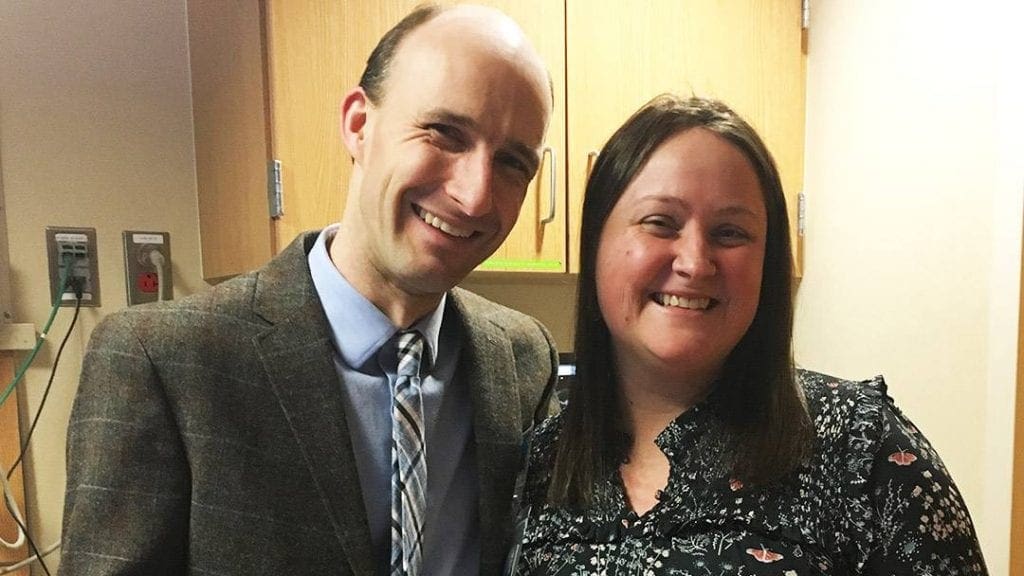Beating Back a Brain Tumor Amid Loss

When Katie Garrison embarked on treatment for a brain tumor, she did so supported by her husband, Joe. Midway through her journey, however, Joe died from complications due to his own cancer, and Katie leaned on her Mayo Clinic care team. Now, with their compassionate care and customized therapies, Katie continues to make encouraging progress.
Katie
Garrison was a happily married, 36-year-old mother from Greenbrier, Arkansas, when
she experienced her first seizure. Several weeks later, while teaching Sunday
school, she experienced a second episode, which caused her body to become
paralyzed and her head to tilt left. The seizures led Katie to seek medical advice,
and she was given the shocking diagnosis of a brain tumor. Katie followed the
advice of her hometown surgeon and soon underwent brain surgery to remove the
tumor.
Following surgery, Katie learned that a significant portion of the tumor, identified as a grade 2 oligodendroglioma, remained in her brain. At the time, Katie was given the choice to receive radiation therapy and chemotherapy immediately, or forgo the additional treatments until the tumor began to grown back.
“They
didn’t give me an answer on whether I should or I shouldn’t,” Katie says. “It
was like, ‘You decide.’ And that’s a tough decision to make.”
Katie had intimate knowledge of the effects of chemotherapy and radiation because her husband, Joe, was diagnosed with chronic lymphocytic leukemia in 2013 and had gone through both. “I had reservations because, a lot of times, when you say chemo and radiation, that’s pretty serious,” Katie says.
Looking for further advice, Katie and Joe visited several top-ranked cancer treatment centers. But none impressed them, Katie says. As news of Katie’s brain tumor and search for a second opinion spread through their social circles, a friend suggested she call Mayo Clinic. “That was the best call I ever made,” Katie says.
The call brought Katie to Mayo Clinic’s Rochester campus, where a team of physicians recommended a multipronged treatment approach involving a second brain surgery, proton beam therapy and chemotherapy to aggressively treat the tumor.
“Even
though I have brain cancer, it has been such a pleasure working with people
here at Mayo,” Katie says.
Comprehensive approach,
customized care
From her first appointment at Mayo Clinic in August 2018 with neurologist Joon Uhm, M.D., in the Department of Neurology, Katie knew she’d found her medical home. “I’ve always felt like everyone is on my team and wants me to get rid of this cancer,” Katie says. “You just feel like they’re on your side. Everyone has been so friendly and gone above and beyond.”
During her appointment with Dr. Uhm, Katie learned that more of her cancer could be safely removed. She was put in touch with Mayo Clinic neurosurgeon Terence Burns, M.D., Ph.D., with the Brain Tumor Program. Katie also learned the invasive nature of the tumor required radiation therapy and chemotherapy to attain the best results.
“Like
most gliomas, Katie’s tumor is infiltrative,” Dr. Burns says. “There
were parts of Katie’s tumor extending into movement and other areas of her
brain we cannot safely remove. But the main bulk of the remaining tumor could
still be safely removed. Surgery is never a complete cure, but removing as much
tumor as safely achievable can help prolong survival.”
Because
Katie’s tumor was located in her right frontal lobe, removing it involved taking
out part of the brain called the supplemental motor cortex, a structure
important for initiating movement. “People almost always regain full
function, but there is a variable period of time, usually days to weeks, right
after surgery when one side of the body won’t move when you want it to,” Dr.
Burns says.
“(Dr. Burns) takes the time, and he goes out of his way to take care of us. He’s been really great.”
Katie Garrison
In
addition to reviewing the surgery with Katie, Dr. Burns explained why radiation
and chemotherapy after surgery were so important. “We spent time trying to
get her used to the idea that, yes, we can consider her for the surgery. But unless
you go through with the rest of the treatment, what I can offer surgically is
going to be much less valuable,” Dr. Burns says.
The
time and attention Dr. Burns gave Katie helped convince her to receive the additional
therapies. “I had contacted Dr. Burns before I came for the surgery, and I
asked him if it was really necessary right now,” says Katie, explaining
that her husband was dealing with ongoing health issues.
Katie
received a detailed response from Dr. Burns, describing what was known about
the natural history of the tumor, and outlining how much time she would need to
get through surgery, rehabilitation and radiation when she was ready to proceed
with treatment.
“He
takes the time, and he goes out of his way to take care of us,” Katie
says. “He’s been really great.”
It’s
important that patients are ready and prepared before undergoing such a major
surgery, Dr. Burns says. “Timing is a balance. Yes, the tumor is likely to
keep slowly growing, but it’s a big investment to go through a surgery like
this knowing that you may not be able to even walk potentially for weeks
afterward.”
Effective therapy, personal
tragedy
Following
Katie’s initial meetings with her Mayo Clinic team, she and Joe, who was
dealing with medical complications due to his disease, returned to Arkansas to manage
his care while they sorted out the details of her surgery. As the weeks and
months passed, Katie had scans to monitor the tumor. In early 2019, imaging
showed it had grown. Katie contacted her Mayo care team to schedule the
surgery.
When
Katie arrived at Mayo Clinic in February, she did so without her husband, who
was hospitalized with pneumonia in their hometown. But on Feb. 22, Katie’s
surgery went on as scheduled. Dr. Burns and his surgical team removed as much
of the tumor, which had increased in size and scope to a grade 3, as safely
possible.
“As
planned, we left the edges of the tumor that were growing into the motor cortex
and deeper parts of the brain,” says Dr. Burns, adding that to remove
malignant tissues in some of those deeper areas had the potential to change
Katie’s personality and her emotional aptitude. “It was not going to be in
her best interest to be overly aggressive.”
When
Katie woke up from surgery, as Dr. Burns had cautioned, she couldn’t move the
left side of her body. “I couldn’t walk. I could hardly move my arm,”
she says. “My face, they said, kind of looked like it drooped a little.”
Katie was transferred to the inpatient rehabilitation unit and worked with physical and occupational therapists to recover her motor function. “Then, of course, I was seeing speech therapy for the cognitive stuff. It was brain surgery after all,” Katie adds.
After
three weeks, Katie regained nearly all of her function. She went home for two
weeks before she was scheduled to begin proton beam therapy at Mayo Clinic. The
therapy uses targeted beams to minimize radiation spillover to healthy tissue and
lowers the risk of radiation-related side effects.
Throughout
April and May, Katie had 30 proton beam therapy sessions at Mayo Clinic to
target the lingering cancer cells. She had completed about two-thirds of her
treatments and was feeling well. But at home, her husband’s fragile situation
took a turn for the worse, and he passed away. Katie went home to plan and
attend his funeral. Despite such a difficult and painful loss, Katie remained committed
to completing her own lifesaving treatment. After the funeral, she returned to
Mayo and finished her proton beam therapy.
Compassionate support,
endless gratitude
For
the next step in her treatment plan, Katie will meet with her Mayo Clinic medical
oncologist Sani
Kizilbash, M.D., and begin oral chemotherapy. She will
take the treatment in six cycles, each lasting between six to eight weeks. Because
the chemotherapy consists of pills, she will be able to stay at home and be
monitored locally for most of her treatment. She’ll return to Mayo between
cycles for more comprehensive evaluation.
“If
everything goes really well, treatment lasts for nine months,” Dr.
Kizilbash says, adding that it’s common for the treatment to extend to 12
months because the chemotherapy hampers the production of blood cells in the
bone marrow, and there is a tendency for the blood counts to take longer to
recover with each cycle of chemotherapy.
Throughout
Katie’s journey, her faith has buoyed her. “Being a Christian and prayer
has definitely helped,” she says. The support Katie has received from her
Mayo Care team, as well family and friends during this time, also has propelled
her forward.
“While we don’t have a cure now, my goal is to give patients as much good quality time as possible, so they can go on with their lives.”
Terence Burns, M.D., Ph.D.
“It’s just phenomenal how caring everyone has been, especially Dr. Burns,” Katie says. “I can contact Dr. Burns anytime, and he gets right back to me. It just means a lot to me, and speaks a lot about the compassion and care they have. Everyone at Mayo is really good people, and everybody seems to work together and is caring.”
Although
Katie’s cancer cannot be cured, the treatment she’s received sets her up for the
best possible outcome. “She has a lot going for her,” Dr. Burns says.
“She’s young. Most of the tumor is out. It’s an oligodendroglioma, which
tends to respond quite well to chemotherapy and radiation. But it’s a stage 3,
and we know there’s tumor remaining, so there’s motivation to stay vigilant.”
For
patients like Katie, it’s important to underscore that, in addition to having
the support of Mayo Clinic neurology experts working to give her the best
treatment possible, there are thousands of physicians and researchers working
to find cures for brain tumors, Dr. Burns adds.
“While
we don’t have a cure now, my goal is to give patients as much good quality time
as possible, so they can go on with their lives,” Dr. Burns says. “Eventually,
the tumor will come back. Everyone in the lab is working super hard, so that
hopefully by the time it does come back, we’ll be a lot smarter about how to
cure these tumors that have proven such a challenge for so long.”
Note: You can learn
more about Katie’s story at www.facebook.com/katiegarrisonsjourney.
HELPFUL LINKS:
- Read more about brain tumors.
- Learn about Mayo’s Brain Tumor Program.
- Check out Neurosurgery and Neurology.
- Learn about the Proton Beam Therapy Program.
- Explore Mayo Clinic.
- Request an appointment.
